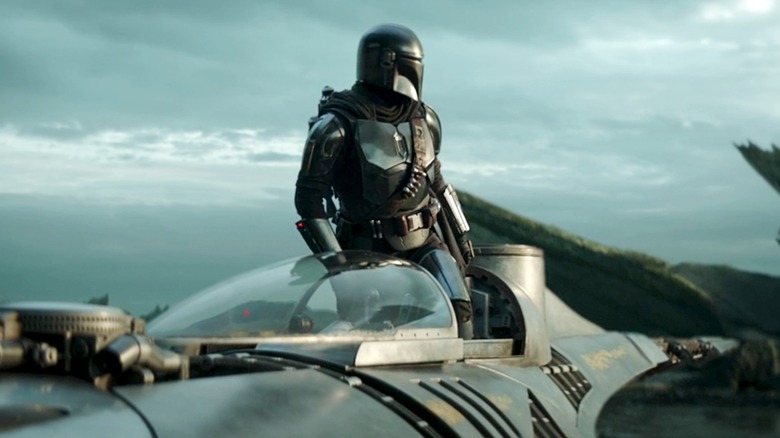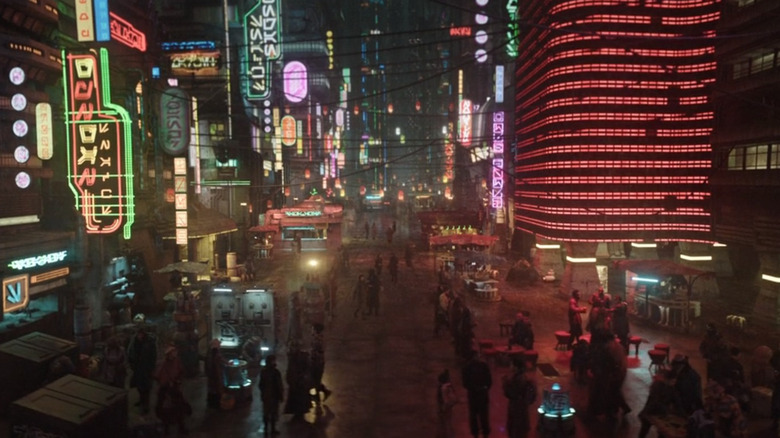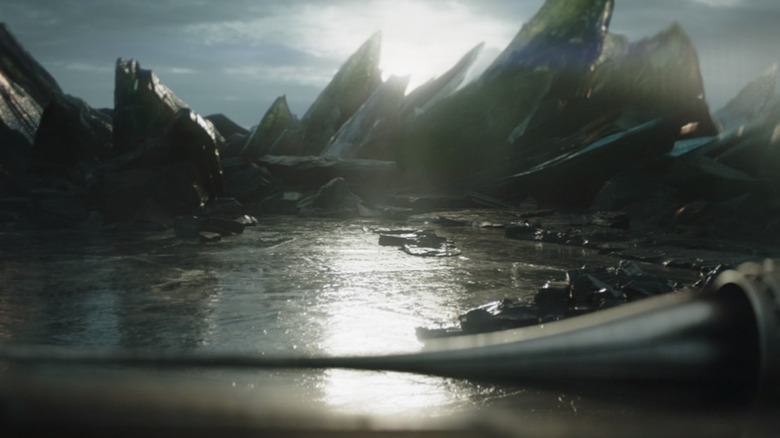The Volume Shows Its Limits In The Mandalorian Season 3 Episode 2
Warning: This article contains spoilers for "The Mandalorian" Season 3 Episode 2.
Mandalore: home to the greatest warriors in all of "Star Wars," aside from (debatably) the Jedi and the Sith. It's a planet with a rich history in both the Legends timeline and the modern canon. Novels, comics, and various animated series have all taken fans to the Mandalorian homeworld, but it's never been depicted in live action — until now.
"The Mandalorian" Season 3 Episode 2 finally sees Din Djarin (Pedro Pascal) and Grogu journey to Mandalore. Despite beliefs held by some other Mandalorians that the planet was "cursed" and "poisoned" after the Great Purge, the atmosphere ends up being totally fine. The surface is still desolate and devastated, however — the result of fusion bombing conducted by the Empire to eradicate all Mandalorians, as well as some older conflicts. In brief, Mandalore has seen better days.
Din's voyage to the home planet he never knew should have been epic. And in many ways, it is. Seeing the old capital city of Sundari so devastated is a powerful moment for "Clone Wars" fans, and Din's journey through the old mines shows his fierce dedication to the creed. Unfortunately, the episode is severely hampered by production decisions — specifically, the continued use of the Volume. The massive soundstage pioneered by "The Mandalorian" Season 1 is great for a lot of things, but it really shows its limits during Din's visit to Mandalore.
The Volume has recently started to show its cracks
For those unfamiliar with the Volume, or who may have forgotten exactly how it works, here's a quick refresher. It's basically a large soundstage surrounded on all sides by massive LED screens. The CGI backdrops necessary for each scene are projected in real time, allowing the actors and filmmakers to see them while shooting. This allows for more realistic lighting in some cases, and it's meant to immerse the performers much more deeply in the world than a green screen ever could.
In theory, that's great. And to be fair, the Volume has been used to tremendous effect in the first two seasons of "The Mandalorian." But more recently, we've started to see the cracks. "Obi-Wan Kenobi" also shot a lot in the Volume, and the effects are lackluster to say the least. At times, the series looks downright bad because there just isn't enough space to build out real locations. Lighting is off, large spaces feel constricted, and the action suffers as a result.
The best way to notice the difference is to compare an episode of "Obi-Wan" with an episode of "Andor," which didn't shoot on the Volume at all. The latter series has much bigger, more vibrant settings because it shot on location and simply augmented certain shots with CGI in post-production.
Din's grand return to Mandalore is almost ruined by the Volume
There is clearly a time and a place for the Volume, but it really shows its limits in "The Mandalorian" Season 3 Episode 2. The fly-in shot of Sundari is striking, revealing the bombed-out dome city in all its fallen glory. But the second Din and Grogu land, the world shrinks exponentially.
They set down on a conveniently flat spot right next to some rubble. There's no sign of the massive urban structures seen from the sky. Din then walks through the rubble into... a cave? Which quickly opens out onto a huge expanse of undercity. He and Grogu drop down through the depths, arriving at the old civic center. There's probably some storyboarded map that explains this layout, but it's incredibly confusing to watch. Most of Sundari is above ground, so why is the whole city shrouded in darkness when the dome is blown open? Why is this tiny opening the only way in? Where, exactly, did Din land?
There's one simple answer to all these questions: The Volume can't do it all. The landing pad area is so clearly a soundstage that you can practically see the camera operators in the background. It's as if they swept the entire stage clean and just threw in a few awkwardly painted Styrofoam "rocks" for good measure. Boom: worldbuilding according to the Volume.
These shortcomings are only magnified by the structure of the episode, which sees Grogu, Din, and Bo-Katan (Katee Sackhoff) backtrack along the same exact path multiple times. There's no grand tour of this iconic location; no real sense of what it used to look like. Our return to Mandalore should have felt epic, but it ends up feeling as tiny as the Volume.


